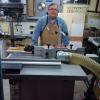I have some sharpening to do. I don't think I will be utilizing the grinder for this as I just have the stock grey wheel on mine. However I had a random thought pop up. Yes, I know dangerous
I have an independent speed control for a router. It should be able to slow down a grinder. Anyone ever use a speed control on their grinder? I was hypothesizing that with a white oxide wheel and slower speed the grinder could come in handy on the chisels. Any comments?






 Reply With Quote
Reply With Quote




